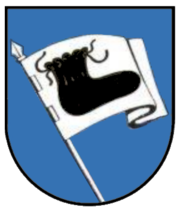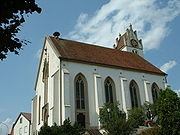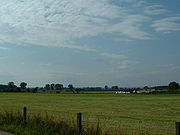
Baltringen
Encyclopedia



Baden-Württemberg
Baden-Württemberg is one of the 16 states of Germany. Baden-Württemberg is in the southwestern part of the country to the east of the Upper Rhine, and is the third largest in both area and population of Germany's sixteen states, with an area of and 10.7 million inhabitants...
in the region of Upper Swabia
Upper Swabia
Upper Swabia is a region in Germany in the federal states of Baden-Württemberg and Bavaria. The name refers to the area between the Swabian Alb, Lake Constance and the Lech...
, situated approximately 17 km north of Biberach
Biberach an der Riß
Biberach is a town in the south of Germany. It is the capital of Biberach district, in the Upper Swabia region of the German state of Baden-Württemberg...
. Administratively, Baltringen is part of the municipality
Municipality
A municipality is essentially an urban administrative division having corporate status and usually powers of self-government. It can also be used to mean the governing body of a municipality. A municipality is a general-purpose administrative subdivision, as opposed to a special-purpose district...
of Mietingen
Mietingen
Mietingen is a municipality in Baden-Württemberg in the region of Upper Swabia, situated approximately 18 km north of Biberach. The river Rottum runs through Mietingen....
. Baltringen lies on the river Dürnach
Dürnach
Dürnach is a river of Baden-Württemberg, Germany.-See also:*List of rivers of Baden-Württemberg...
.
History
The area in which the village of Baltringen is now situated, was settled by Alemans in the 3rd century CE, being part of the Agri DecumatesAgri Decumates
The agri decumates or decumates agri were a region of the Roman Empire's province of Germania superior , covering the Black Forest area between the Main river and the sources of Danube and Rhine rivers, presently in Southwestern Germany...
. It is located on an important road, connecting Ulm
Ulm
Ulm is a city in the federal German state of Baden-Württemberg, situated on the River Danube. The city, whose population is estimated at 120,000 , forms an urban district of its own and is the administrative seat of the Alb-Donau district. Ulm, founded around 850, is rich in history and...
with Lake Constance
Lake Constance
Lake Constance is a lake on the Rhine at the northern foot of the Alps, and consists of three bodies of water: the Obersee , the Untersee , and a connecting stretch of the Rhine, called the Seerhein.The lake is situated in Germany, Switzerland and Austria near the Alps...
. This road was partly restored in the early 7th century and new settlements were founded in order to safeguard travelling. The road lead from Meersburg
Meersburg
Meersburg is a town of Baden-Württemberg in the southwest of Germany at Lake Constance.It is famous for its charming medieval city. The lower town and upper town are reserved for pedestrians only and connected by two stairways and a steep street .-History:The name of the town means "Burg on the...
via Ravensburg
Ravensburg
Ravensburg is a town in Upper Swabia in Southern Germany, capital of the district of Ravensburg, Baden-Württemberg.Ravensburg was first mentioned in 1088. In the Middle Ages, it was an Imperial Free City and an important trading centre...
to
Birkendorf
Biberach an der Riß
Biberach is a town in the south of Germany. It is the capital of Biberach district, in the Upper Swabia region of the German state of Baden-Württemberg...
, continuing via Baltringen in the direction of Laupheim
Laupheim
Laupheim is a city in southern Germany in the state of Baden Württemberg. Laupheim was first mentioned in 778 and gained its city rights in 1869. One of the main trading routes, from Ulm to Ravensburg and then on towards Lake Constance ran through Laupheim...
and then on towards Ulm. This road would have crossed the river Dürnach on the southern entrance of the village by using the existing sandstone bridge.
The first appearance of Baltringen in written sources dates from 1274, when two brothers, Ulrich and Berthold of Baltringen, are mentioned. It is, however, impossible to ascertain a to whether these brothers were of the nobility
Nobility
Nobility is a social class which possesses more acknowledged privileges or eminence than members of most other classes in a society, membership therein typically being hereditary. The privileges associated with nobility may constitute substantial advantages over or relative to non-nobles, or may be...
or not. There is evidence of high court
High Justice
High Justice is a 1974 collection of science fiction short stories by Jerry Pournelle. It was republished in a omnibus edition with Exiles to Glory in 2009 as Exile -- and Glory....
activity in Baltringen; on old maps a place called Galgenberg (gallow's hill) can be found on the road towards Äpfingen
Maselheim
Maselheim is a town in the district of Biberach in Baden-Württemberg in Germany....
.
In 1370, a subsidiary church of the parish
Parish
A parish is a territorial unit historically under the pastoral care and clerical jurisdiction of one parish priest, who might be assisted in his pastoral duties by a curate or curates - also priests but not the parish priest - from a more or less central parish church with its associated organization...
church in Laupheim is mentioned as being in Baltringen. During the 14th century, the Herren von Freyberg of Achstetten
Achstetten
Achstetten is a the northernmost municipality in the district of Biberach, in the region of Upper Swabia in Baden-Württemberg, Germany. As of 30 September 2008, it has a population of 4.141....
were the rulers of Baltringen, also owing the right to inflict low justice. During the 15th century, Baltringen changed hands frequently. A great number of owners were burghers
Bourgeoisie
In sociology and political science, bourgeoisie describes a range of groups across history. In the Western world, between the late 18th century and the present day, the bourgeoisie is a social class "characterized by their ownership of capital and their related culture." A member of the...
of Ulm and Biberach. Little by little the Spital (a hospital foundation) in Biberach bought more and more of Baltringen, so that in 1473 almost all of the village was in its possession.
During the German Peasants' War
German Peasants' War
The German Peasants' War or Great Peasants' Revolt was a widespread popular revolt in the German-speaking areas of Central Europe, 1524–1526. At its height in the spring and summer of 1525, the conflict involved an estimated 300,000 peasants: contemporary estimates put the dead at 100,000...
1524-1525, Baltringen was a centre of the rebellion. The regional peasants' army was named after the village, Baltringer Haufen
Baltringer Haufen
The Baltringer Haufen was prominent among several armed groups of peasants and craftsmen during the German Peasants' War of 1524-1525. The name derived from the small Upper Swabian village of Baltringen, which lies approximately south of Ulm in the district of Biberach, Germany...
. The revolt failed when troops of the Swabian League
Swabian League
The Swabian League was an association of Imperial States - cities, prelates, principalities and knights - principally in the territory of the Early medieval stem duchy of Swabia, established in 1488 at the behest of Emperor Frederick III of Habsburg and supported as well by Bertold von...
beat the Baltringer Haufen in a battle fought on nearby Baltringer Ried (Baltringen Bog
Bog
A bog, quagmire or mire is a wetland that accumulates acidic peat, a deposit of dead plant material—often mosses or, in Arctic climates, lichens....
). Only in the first half of the 19th century, the last remnants of servitude
Servitude
Servitude may refer to:* Service* Conscription* Employment* Slavery* Indentured servitude* Involuntary servitude* Penal servitude* Servitude * Equitable servitude, a term of real estate law* Servitude in civil law...
were abolished.
In 1636, during the Thirty Years' War
Thirty Years' War
The Thirty Years' War was fought primarily in what is now Germany, and at various points involved most countries in Europe. It was one of the most destructive conflicts in European history....
, the population of Baltringen was almost completely wiped out by bubonic plague
Bubonic plague
Plague is a deadly infectious disease that is caused by the enterobacteria Yersinia pestis, named after the French-Swiss bacteriologist Alexandre Yersin. Primarily carried by rodents and spread to humans via fleas, the disease is notorious throughout history, due to the unrivaled scale of death...
.
In the course of the mediatisation in 1803, the main part of the village came into the possession of the Counts of Plettenberg und Bassenheim
House of Plettenberg
The House of Plettenberg is a Westphalian noble family of the Uradel. It dates back at least to 1187, when Heidolphus de Plettenbrath was mentioned in a document by Philip I...
. In 1806, Baltringen became part of the Kingdom
Monarchy
A monarchy is a form of government in which the office of head of state is usually held until death or abdication and is often hereditary and includes a royal house. In some cases, the monarch is elected...
of Württemberg
History of Württemberg
Württemberg developed as a political entity in south-west Germany, with the core established around Stuttgart by Count Conrad . His descendants managed to expand Württemberg, surviving Germany's religious wars, changes in imperial policy, and invasions from France. The state had a basic...
.
Until 1938, Baltringen was part of the district
District
Districts are a type of administrative division, in some countries managed by a local government. They vary greatly in size, spanning entire regions or counties, several municipalities, or subdivisions of municipalities.-Austria:...
of Laupheim; since then it has been part of the district of Biberach.
Attractions
- The village of Baltringen is situated on the Upper Swabian Baroque RouteUpper Swabian Baroque RouteThe Upper Swabian Baroque Route is a touristic theme route through Upper Swabia, following the themes of "nature, culture, baroque". The route has a length of about 500 km . It was established in 1966, being one of the first theme routes in Germany...
, a touristic route along the most notable architectural relics of Baroque-style in Upper Swabia. - Baltringer Schichten (Baltringen strata): deposits of molasseMolasseThe term "molasse" refers to the sandstones, shales and conglomerates formed as terrestrial or shallow marine deposits in front of rising mountain chains. The molasse is deposited in a foreland basin, especially on top of flysch, for example that left from the rising Alps, or erosion in the Himalaya...
, created when ca. 25 million years ago, sea covered the area from the river RhoneRhône RiverThe Rhone is one of the major rivers of Europe, rising in Switzerland and running from there through southeastern France. At Arles, near its mouth on the Mediterranean Sea, the river divides into two branches, known as the Great Rhone and the Little Rhone...
to what now is the cityCityA city is a relatively large and permanent settlement. Although there is no agreement on how a city is distinguished from a town within general English language meanings, many cities have a particular administrative, legal, or historical status based on local law.For example, in the U.S...
of ViennaViennaVienna is the capital and largest city of the Republic of Austria and one of the nine states of Austria. Vienna is Austria's primary city, with a population of about 1.723 million , and is by far the largest city in Austria, as well as its cultural, economic, and political centre...
; a regional, temporary rise created a rough area of sandstone. Here, a geologistGeologistA geologist is a scientist who studies the solid and liquid matter that constitutes the Earth as well as the processes and history that has shaped it. Geologists usually engage in studying geology. Geologists, studying more of an applied science than a theoretical one, must approach Geology using...
collected ca. 60 000 teeth of various sharkSharkSharks are a type of fish with a full cartilaginous skeleton and a highly streamlined body. The earliest known sharks date from more than 420 million years ago....
speciesSpeciesIn biology, a species is one of the basic units of biological classification and a taxonomic rank. A species is often defined as a group of organisms capable of interbreeding and producing fertile offspring. While in many cases this definition is adequate, more precise or differing measures are...
in the 19th century. The collection is now on display in the Braith-Mali Museum in Biberach an der Riß.

